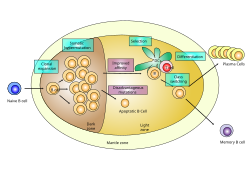
Back Germ-centar BS Germinální centrum Czech Keimzentrum German Centro germinal Spanish مراکز زایا Persian Centre germinatif French Centro xerminal Galician מרכז נבט HE Pusat germinal ID 胚中心 Japanese
This article needs additional citations for verification. (May 2016) |
| Germinal center | |
|---|---|
 Germinal center of a lymph node showing proliferation and development stages of a B cell. | |
| Identifiers | |
| MeSH | D018858 |
| Anatomical terminology | |
Germinal centers or germinal centres (GCs) are transiently formed structures within B cell zone (follicles) in secondary lymphoid organs – lymph nodes, ileal Peyer's patches, and the spleen[1] – where mature B cells are activated, proliferate, differentiate, and mutate their antibody genes (through somatic hypermutation aimed at achieving higher affinity) during a normal immune response; most of the germinal center B cells (BGC) are removed by tingible body macrophages.[2] There are several key differences between naive B cells and GC B cells, including level of proliferative activity, size, metabolic activity and energy production.[3] The B cells develop dynamically after the activation of follicular B cells by T-dependent antigen. The initiation of germinal center formation involves the interaction between B and T cells in the interfollicular area of the lymph node, CD40-CD40L ligation, NF-kB signaling and expression of IRF4 and BCL6.[4]
GC B cells cycle through the two distinct zones of the germinal center: the light zone and the dark zone.[3][4][5][6] As they undergo rapid and mutative cellular division, B cells of the germinal center's dark zone are known as centroblasts. Once these B cells have stopped proliferating in the dark zone and moved to the light zone, they are known as centrocytes, and are subjected to selection by follicular helper T (TFH) cells in the presence of follicular dendritic cells (FDCs).[3][4][5][6] There are three possible fates for GC B cells that have been positively selected in the light zone: plasma cell, memory B cell or B cell licensed to return to the dark zone for proliferation and mutation.[4][6] These three fates are achieved via the distinct mechanisms described below. Germinal centers are an important part of the B cell humoral immune response, acting as central factories for the generation of affinity matured B cells specialized in producing improved antibodies that effectively recognize antigen (e.g. infectious agents), and for the production of long-lived plasma cells and durable memory B cells.
- ^ Natkunam Y (1 January 2007). "The biology of the germinal center". Hematology. American Society of Hematology. Education Program. 2007: 210–215. doi:10.1182/asheducation-2007.1.210. PMID 18024632.
- ^ Aguzzi A, Kranich J, Krautler NJ (March 2014). "Follicular dendritic cells: origin, phenotype, and function in health and disease". Trends in Immunology. 35 (3): 105–113. doi:10.1016/j.it.2013.11.001. PMID 24315719.
- ^ a b c Victora, Gabriel D.; Nussenzweig, Michel C. (26 April 2022). "Germinal Centers". Annual Review of Immunology. 40 (1): 413–442. doi:10.1146/annurev-immunol-120419-022408. ISSN 0732-0582.
- ^ a b c d Kennedy, Domenick E.; Clark, Marcus R. (31 March 2021). "Compartments and Connections Within the Germinal Center". Frontiers in Immunology. 12. doi:10.3389/fimmu.2021.659151. ISSN 1664-3224. PMC 8045557. PMID 33868306.
- ^ a b Choi, Seung-Chul; Morel, Laurence (March 2020). "Immune metabolism regulation of the germinal center response". Experimental & Molecular Medicine. 52 (3): 348–355. doi:10.1038/s12276-020-0392-2. ISSN 2092-6413. PMC 7156389. PMID 32132626.
- ^ a b c Lau, Angelica WY; Brink, Robert (1 April 2020). "Selection in the germinal center". Current Opinion in Immunology. Lymphocyte development and activation. 63: 29–34. doi:10.1016/j.coi.2019.11.001. ISSN 0952-7915.